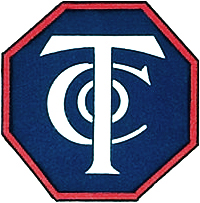
The Thanhouser Company was one of the first motion picture studios, founded in 1909 by Edwin Thanhouser, his wife Gertrude and his brother-in-law Lloyd Lonergan. It operated in New York City until 1920, producing over a thousand films.

She's Done it Again is a 1910 American silent short comedy written by Lloyd Lonergan and produced by the Thanhouser Company in New Rochelle, New York. A thief named Sikes decides to rob a society woman who falsely claimed to have been robbed when she in fact pawned her jewelry. A gentleman thief strikes and robs her, but no one believes her. The thief is caught only by a clever detective. The film was the third release of the Thanhouser company and featured the leading players, Anna Rosemond and Frank H. Crane. The film was met with positive reviews, but is presumed to be lost.

Jane Eyre is a 1910 American silent short classic drama produced by the Thanhouser Film Corporation. Adapted from Charlotte Brontë's 1847 novel, Jane Eyre, the film mirrors the events and plot of the original book. The writer of the scenario is unknown, but Lloyd Lonergan probably adapted the work. The film's director is often and erroneously claimed to be Theodore Marston, but Barry O'Neil or Lloyd B. Carleton are possible candidates. The cast of the film was credited, an act rare and unusual in the era.
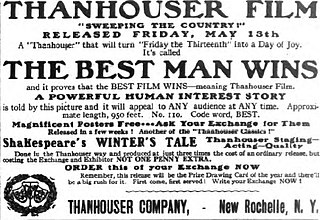
The Best Man Wins is a 1910 American silent short drama produced by the Thanhouser Company. The film features Thanhouser's leading players Anna Rosemond, Martin Faust, Frank H. Crane and Marie Eline in a drama about morality. Two suitors are vying for the hand of Julia Seaton and propose to her on the same day, but she asks for a month to decide between them. In the time, the caliber of both men are tested when asked by a young girl, named May, to help her dying mother. The doctor refuses to help, and the lawyer offers his assistance, but her mother soon dies. The orphan is taken in by the Seaton family and personally attests to the character of both men when Julia Seaton has to choose between her suitors.
Cupid at the Circus is a 1910 American silent short drama produced by the Thanhouser Company. The film is a romance with a storyline focused around a country boy who follows a circus parade to the circus grounds and becomes intent on sneaking into the show. He is discovered, but before he can be ejected, a girl asks her father to buy him a ticket of admission. Thankful, the boy gives her his pocket knife. Years later the two meet again and when he sees her using his pocket knife. He proposes and she accepts. Not too much is known for certain about the production of this film, including the writer, director and photographer credits. The circus scenes were done with special arrangement by Barnum & Bailey. The film was released on May 20, 1910, to favorable reviews. The film is presumed lost.

The Writing on the Wall is a 1910 American silent short drama produced by the Thanhouser Company. Directed by Barry O'Neil from a script by Lloyd Lonergan, this presumed lost film focuses on a young girl named Grace who becomes attracted to a wealthy man named Jack. Two men, named Turner and Hank plot to rob Jack after he withdraws a large sum of money from a bank, but Grace warns him of a plot to drug him. Jack escapes and marries Grace. The film has no known trade publication reviews, but reviews may exist for this film. Theaters were advertising this film as late as 1913.

The Little Hero of Holland is a 1910 American silent short drama produced by the Thanhouser Company. It is an adaptation of the short fictional story popularized in Hans Brinker, or The Silver Skates, about a boy who plugs a leaking dike with his finger to prevent it from bursting. The role of the boy was played by Marie Eline, but little else is known about the production and cast of the film. The director may have been Barry O'Neil and the writer may have been Lloyd Lonergan. Parts of the film were shot on Glen Park Island in New Rochelle, New York. The film was released on June 17, 1910 and saw a wide release, including the United Kingdom. The film is presumed lost.
Thelma is a 1910 American silent short drama film produced by the Thanhouser Company. The story was based on Marie Corelli's 1887 novel of the same name, it focuses on a Norwegian maiden who meets Sir Phillip and the two are wed. Lady Clara conspires to ruin the marriage and tricks Thelma with a letter purported to be from her husband. Thelma returns to Norway and to the death of her father. Thelma, alone in the world, prays at her mother's grave for strength. Sir Phillip searches for Thelma, ultimately finding her, uncovers the tricks which have been played on them and they fall back in love. Released on June 21, 1910, the film was met with praise in The Moving Picture World. An incomplete print of the film survives in the Library of Congress archives.

The Governor's Daughter is a 1910 American silent short drama produced by the Thanhouser Company. The story details a convict who is being sent to prison when the train is wrecked and the sheriff escorting him is killed. The convict frees himself, but halts his escape to save the life of a little girl. As he returns the girl to her nurse, a policeman identifies and recaptures him. Later the little girl accompanies her father, the governor, on a tour of the prison and the father pardons the hero-convict. The film included scenes of a real train wreck and the scenario was written around the filming of the disaster. The film received praise for the before and after scenes which were described as shocking to The Moving Picture World's reviewer. The film was released on June 24, 1910, and was shown as far away as Australia. The film is presumed lost.

The Girl Strike Leader is a 1910 American silent short drama produced by the Thanhouser Company. The film deals with labor relations when Hal Stephens disguises himself and works in a factory he was given by his father. As a laborer, he falls in love with a young working girl named Lou and protects her against a manager. Lou leads a strike when wages are ordered to be cut by 10%, but the strikers return to work on the verge of starvation. Lou, who resists, is saved by Hal who assumes control, restores the wages and removes the previous manager.

The Converted Deacon is a 1910 American silent short drama produced by the Thanhouser Company. The film follows the daughter who disobeys her father by associated with the theater and becomes a star on the stage. She keeps it a secret, but he father arrives in town and takes her home because her mother is ill. John DeLacy follows her home and disguises himself to secure a position on the farm. A newspaper reveals the daughter's fame and only after a song and dance does the father's anger abate and allows the two lovers to marry. Little is known about the production of the film, but the Thanhouser films were distinguished as being the best of the Independent companies in a The New York Dramatic Mirror editorial. The film was released on July 15, 1910, and met with mixed reception. The film is presumed lost

The Mermaid is a 1910 American silent short comedy produced by the Thanhouser Company. The film focuses on John Gary, a hotel owner, who wants to revitalize his business. After reading about a reported mermaid sighting, he has his daughter Ethel pose as a mermaid and gets a newspaper reporter to witness and photograph the mermaid. The publicity results in the hotel becoming famous, but Ethel eventually discloses the joke to the guests of the hotel in her mermaid suit. The film was released on July 29, 1910 and was met with mostly positive reviews. The film is presumed lost.
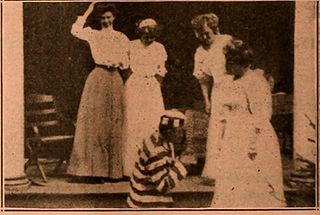
Jenks' Day Off is a 1910 American silent short comedy produced by the Thanhouser Company. The film follows Mr. Jenks who drafts a telegram to himself as an excuse to get a reprieve from boredom and his wife's requests. He walks along the beach and finds a secluded spot to go swimming. A convict in women's clothing swaps his clothes with Jenks and Jenks has no choice to but to wear the discarded clothes. On his way back, he answers a call for help and is mistaken for the robber. He is captured and has to explain the circumstances which lead to an awkward situation. Production and casting credits for the film are unknown, but likely Thanhouser staff offer possible identities of the writer and actors. The film was released on August 2, 1910 and was met with approval by the trade publication. The film is presumed lost.
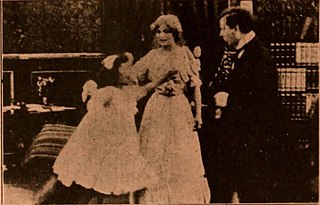
The Restoration is a 1910 American silent short drama produced by the Thanhouser Company. The film focuses on Hugh Logan, a single father who leaves his little girl, May, at home when he goes on a business trip. On the way to the city he is attacked by robbers and left in the road. He is found and taken in, but he suffers from amnesia. He falls in love with Maud Neals and proposes to her. Due to the prolonged absence of her father, May is taken to an orphan asylum, but she escapes. May goes to the city and ends up stopping to sleep on the doorstep of the Neals' home. Maud finds her and takes her in, where Logan recognizes his daughter and his memory comes back. Little is known of the production credits, but the film does feature Marie Eline as the little girl. It was released on August 5, 1910 and was met with mixed reviews. The film is presumed lost.

Lena Rivers is a 1910 American silent short drama produced by the Thanhouser Company. The film follows a young woman who leaves home to search for employment and becoming married to a wealthy man, but the marriage is kept secret. The husband is arrested by mistake and by the time he is freed, his wife and child depart and he believes them dead. The young woman entrusts her baby, Lena, to her mother before her death. At age 16, Lena goes to the city is visited by her father, but the relationship is only known when he sees a picture of her mother in her locket. The film was an adaptation of Mary Jane Holmes' 1856 novel Lena Rivers and was released on August 12, 1910. It had a wide national release and received positive reviews from critics.

The Girl Reporter is a 1910 American silent short drama produced by the Thanhouser Company. The film follows two sweethearts, May and Will, who are reporters for the Daily Wave newspaper. Will leaves the newspaper to work as a secretary to Blake, the commissioner of public works. Blake takes a bribe and blames Will and fires him. May sets out to clear his name and becomes Blake's new secretary. May investigates and clears Will's name while proving Blake's corruption. The film was released on August 16, 1910 and saw a wide national release. The film received mixed responses from critics who liked the acting, but found issues with the staging and the plausibility of the plot. The film is presumed lost.

Pocahontas is a 1910 American silent short drama produced by the Thanhouser Company. The scenario was written by Lloyd Lonergan based on Lydia Sigourney's 1841 Pocahontas poem. The film is a retelling of the well-known story of Pocahontas, played by Anna Rosemond who saves the life of Captain John Smith, played by George Barnes. She is captured and held hostage by the English, converts to Christianity and marries Rolfe, played by Frank H. Crane. Pocahontas then sickens and dies, spending her last hours wishing to return to her native home. Released on October 11, 1910, the film was met with praise by most reviewers. It is believed that a replica of Hendrik Hudson's ship, Halve Maen, was used for the opening scene to establish the Jamestown landing. Though minor costuming and historical accuracy errors were pointed out, the film was praised as being of the highest quality of any Independent company. The film is presumed lost.
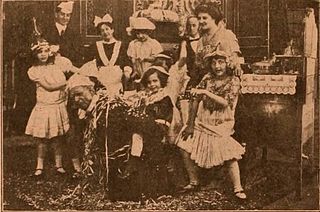
Their Child is a 1910 American silent short drama produced by the Thanhouser Company. The film begins with Ellen Stokes whose extravagant lifestyle is outside the means of the family. While their only son is hosting a birthday party, the husband informs Ellen that they are financially ruined because of her. Ellen attempts to get money from her uncle, who refuses, and a friend of the family soon comes to her aid with a loan. Ellen is deceptive in telling who provided the money and her jealous husband soon learns the truth. In anger, he takes the child and leaves. The child soon returns to Ellen and she whisks him away to a new home where she fails to obtain gainful employment. The son decides to sell newspapers for some money and in this job is recognized by his father, soon the family is reunited. Marie Eline played the role of "their child" and was likely so well disguised that the reviewer for The Nickelodeon believed her to be a boy. The film was released on October 21, 1910, and was met with positive reviews. The film is presumed lost.

The Girls He Left Behind Him and The Iron Clad Lover are two 1910 American silent short comedies produced by the Thanhouser Company. Both films were originally released together on a single reel and are two distinct and separate subjects. The Girls He Left Behind Him focuses on a young man, Jack Redfern, who receives a letter from an old sweetheart of his. This prompts him to reminiscence about all the girls he has had affections for on the eve of his wedding. All the old sweethearts of his life then appear at his wedding to wish him well. The Iron Clad Lover concerns two suitors who are vying for the affections of Bessie. Tom, who plays a game of chess with her father, ends up quarreling with him and he is thrown out of the house. The next day, Tom attempts to bring flowers and candy for Bessie's birthday, but is dismissed by the angry father. Tom decides to dress up in a suit of armor and ends up breaking a vase when trying to announce himself. The suit of armor is thrown out and Bessie and the other suitor chase down the junk dealer to free Tom from the suit of armor. Both films were released on December 9, 1910 and were met with positive reviews by The Moving Picture World and the New York Dramatic Mirror. Both films are presumed lost.

Everybody Saves Father and The Only Girl in Camp are two 1910 American silent short films produced by the Thanhouser Company. Both films were released together on a single reel on January 10, 1911. Everybody Saves Father is a comedy focusing on a father whose life is planned to be saved by a succession of his daughter's suitors. The plan of each of the three men work, foiling the attempts of the other, but a four suitor has wed the daughter whilst the scheming was done by the others. The Only Girl in Camp is a drama film focusing on the only girl in a mining town who foils an armed robbery with the use of bear traps. In 2009, The Only Girl in Camp was identified and deposited into the Library of Congress for preservation. The only known credits for the production come from film stills from the film. The reviews for Everybody Saves Father were positive, but The Only Girl in Camp was met with more or less neutral reception.

















